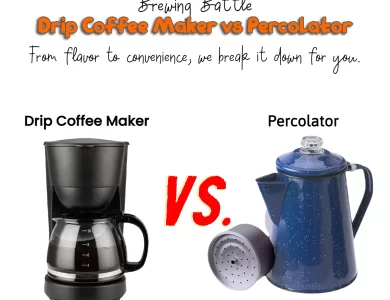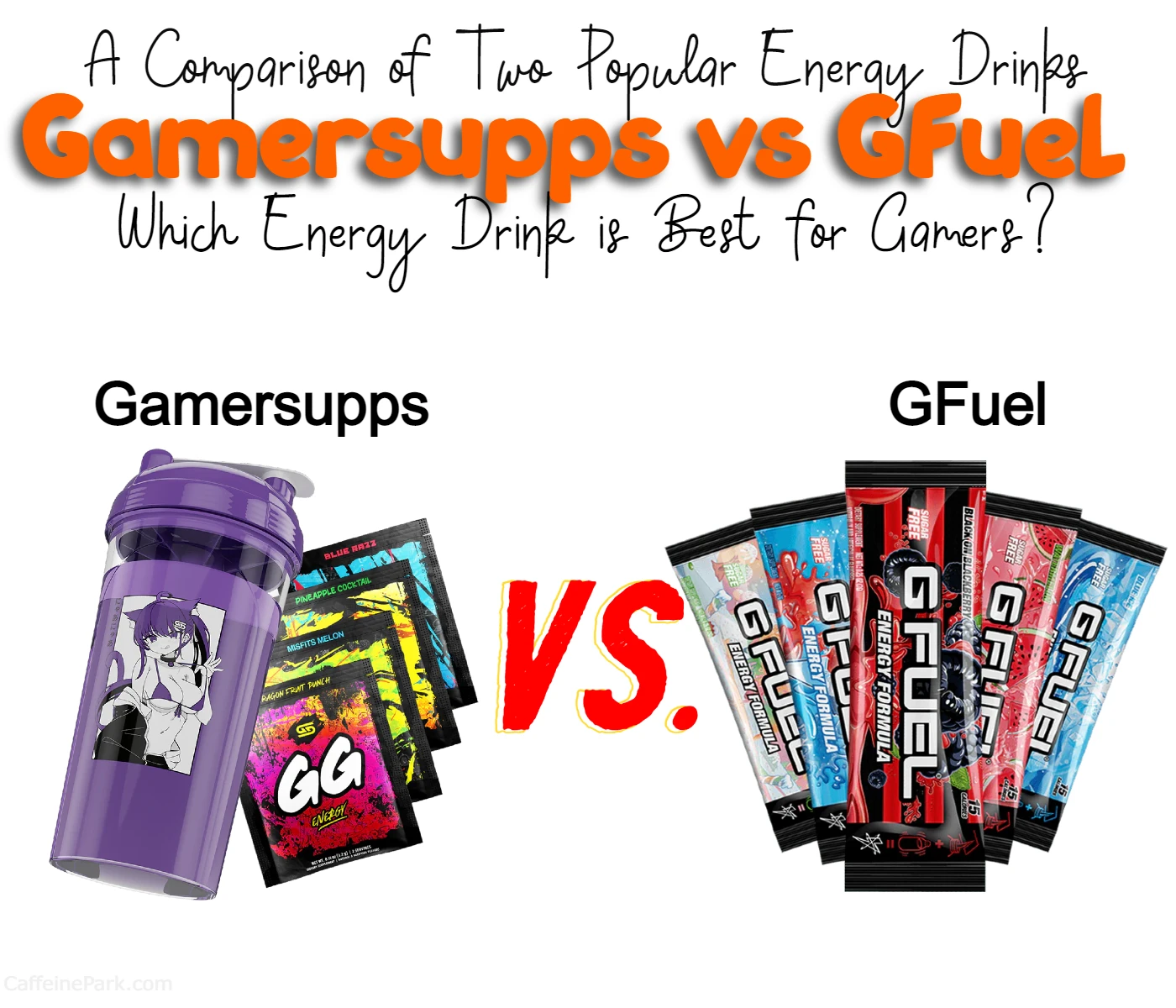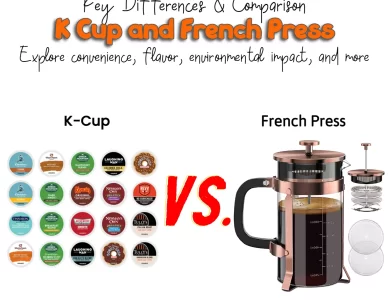Difference between cold brew and iced coffee
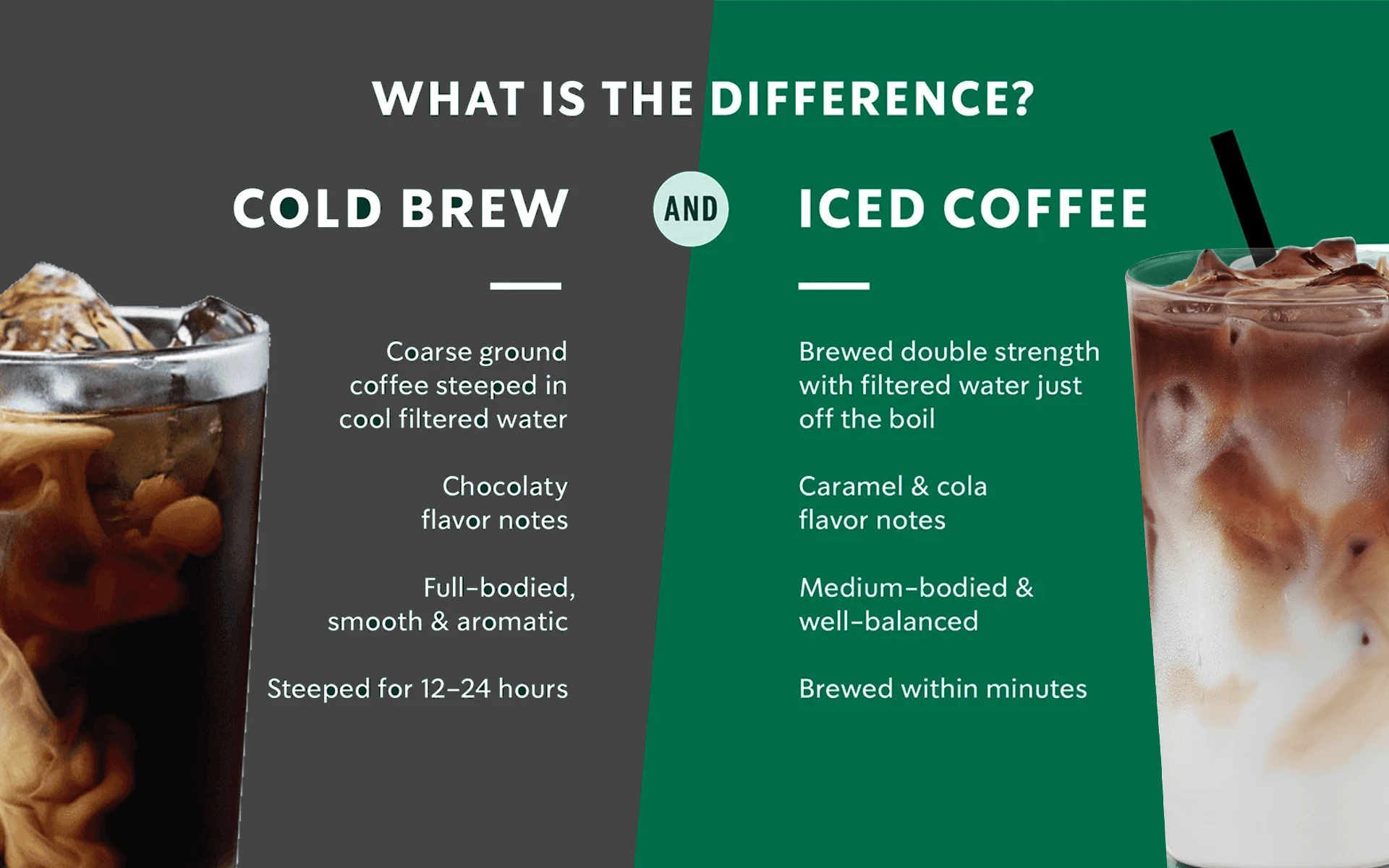
When it comes to cold coffee drinks, the choice can be overwhelming. Do you go for an iced coffee or a cold brew? Which one would you rather have? And how do they differ? Let’s take a closer look and find out the answers to those questions.
Cold brew coffee and iced coffee are two popular types of coffee drinks that are served chilled. While they are both made using coffee and are often served with ice, they are made using different brewing methods and can have distinct flavor profiles. Cold brew coffee is known for its smooth, rich, and less acidic flavor, while iced coffee can have a more acidic and bright flavor. Cold brew coffee also tends to have less caffeine and a lower acid content than iced coffee. Additionally, cold brew coffee has a longer shelf life than iced coffee.
What is Iced Coffee?
Iced coffee is coffee that is brewed hot and then chilled by pouring it over ice. The flavor of iced coffee can vary depending on the brewing method and the type of beans used. Some people prefer iced coffee made from dark roast beans because it can have a bolder flavor that stands up well to the ice. Other people prefer iced coffee made from light roast beans because it can be sweeter and more delicate.
What is Cold Brew Coffee?
Cold brew coffee is made by steeping coarse coffee grounds in cold water for an extended period of time, usually 12-24 hours. The coffee grounds are typically placed in a container, and cold water is added to the container and allowed to steep for several hours or overnight. The resulting coffee is then strained to remove the grounds, and it is usually diluted with water or milk before being served.
The process of making cold brew coffee is relatively simple, and it requires few special tools or equipment. All you need is a container to steep the coffee in, a way to filter the coffee to remove the grounds, and a refrigerator to store the finished product. Cold brew coffee can be made in small batches or in large quantities, depending on your needs.
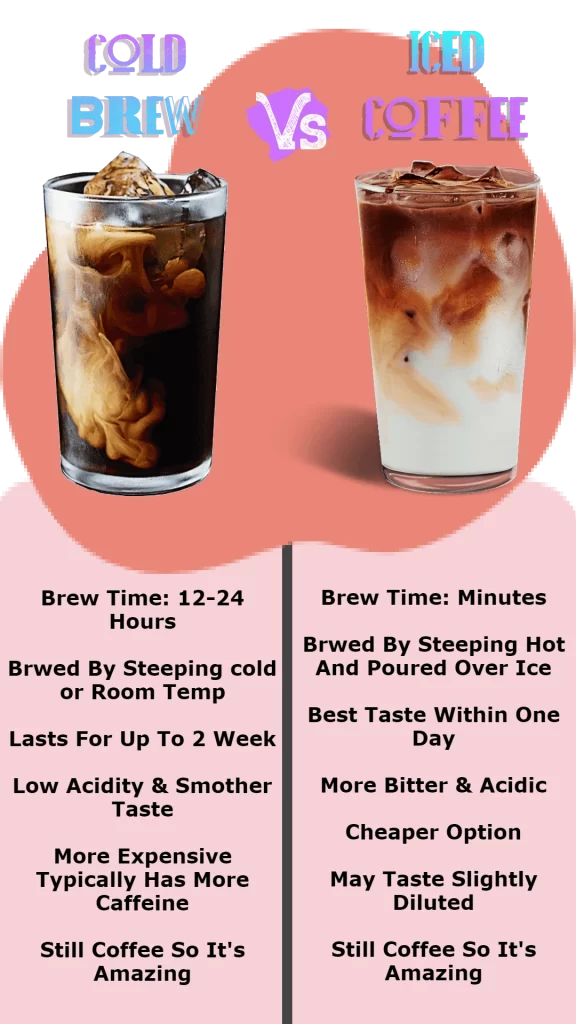
Iced Coffee vs. Cold Brew
Preparation: Cold Brew vs. Iced Coffee
One of the main differences between cold brew coffee and iced coffee is the brewing method. Cold brew coffee is made by steeping coffee grounds in cold water, while iced coffee is made by brewing hot coffee and then chilling it. This means that the flavor profiles of the two drinks can be quite different. Cold brew coffee is known for its smooth, chocolatey flavor, while iced coffee can have a more acidic and bright flavor depending on the brewing method and the type of beans used.
Another difference between cold brew coffee and iced coffee is the time it takes to prepare. Cold brew coffee takes longer to prepare because it requires an extended steeping time, usually 12-24 hours. Iced coffee, on the other hand, can be prepared more quickly because it is brewed using hot water and requires a shorter steeping time.
Overall, the preparation methods for cold brew coffee and iced coffee are quite different, and they result in distinct flavor profiles. Cold brew coffee is known for its smooth, rich, and less acidic flavor, while iced coffee can have a more acidic and bright flavor depending on the brewing method and the type of beans used.
Caffeine Content: Cold Brew vs. Iced Coffee
Overall, the main difference between cold brew coffee and iced coffee in terms of caffeine content is that cold brew coffee tends to have less caffeine than iced coffee. This is because the brewing process for cold brew coffee is longer and uses a higher coffee-to-water ratio, which results in a more concentrated coffee that is then diluted before being served. Iced coffee, on the other hand, is brewed quickly using hot water and a lower coffee-to-water ratio, so it tends to have more caffeine.
It is worth noting that the caffeine content of coffee can vary widely depending on a number of factors, including the type of beans used, the roast level, the brewing method, and the serving size. The caffeine content of cold brew coffee and iced coffee can also be affected by the addition of milk, cream, or other flavorings.
Caffeine in cold Brews
The caffeine content of cold brew coffee can also vary depending on the type of coffee beans used, the brewing method, and the serving size. Here are some general guidelines for the caffeine content of cold brew coffee:
| Variety of cold coffee | Serving Size | Caffeine |
|---|---|---|
| Bizzy Cold Brew | 2.67 fl oz. | 125 mg |
| Califia Farms Cold Brew Coffee | 8 fl oz. | 180 mg |
| Caribou Canned Cold Brew | 11.5 | 177 mg |
| Chameleon Cold Brew Coffee | 8 fl oz. | 520 mg |
| Chameleon Cold Brew RTD | 10 fl oz. | 230 mg |
| Chameleon Cold Brew With Milk | 11 fl oz. | 100 mg |
| Death Wish Canned Cold Brew | 8 fl oz. | 300 mg |
| Dunkin’ Cold Brew | 24 fl oz. | 260 mg |
| La Colombe Cold Brew | 9 fl oz. | 180 mg |
| Steep 18 Cold Brew | 8 fl oz. | 90 mg |
| Stok Cold Brew | 13.7 fl oz. | 145 mg |
| Stumptown Cold Brew Coffee | 10.5 fl oz. | 279 mg |
| Stumptown Nitro Cold Brew | 11 fl oz. | 330 mg |
| Wide Awake Coffee Cold Brew | 11 fl oz. | 120 mg |
Caffeine in Iced coffees
The caffeine content of iced coffee can vary depending on the type of coffee beans used, the brewing method, and the serving size. Here are some general guidelines for the caffeine content of iced coffee:
| Variety of Iced coffee | Serving size | Caffeine |
|---|---|---|
| Barista Bros Iced Coffee | 16.91 fl oz. | 140 mg |
| Biggby Iced Coffee | 16 fl oz. | 155 mg |
| Chick-fil-A Iced Coffee | 14 fl oz. | 80 mg |
| Dare Iced Coffee | 16.91 fl oz. | 160 mg |
| Dunkin’ Donuts Iced Coffee | 24 fl oz. | 297 mg |
| Dunkin’ Donuts Iced Latte | 24 fl oz. | 166 mg |
| International Delight Iced Coffee | 12 fl oz. | 88 mg |
| McDonalds Iced Coffee | 11.5 fl oz. | 133 mg |
| Peet’s Iced Coffee | 16 fl oz. | 150 mg |
| Peet’s Iced Latte | 16 fl oz. | 140 mg |
| Peet’s Iced Mocha | 16 fl oz. | 165 mg |
| Starbucks Iced Americano | 16 fl oz. | 225 mg |
| Starbucks Iced Espresso Classics | 12 fl oz. | 125 mg |
| V Iced Coffee | 16.91 fl oz. | 155 mg |
| Wide Awake Iced Coffee Drinks | 13.7 fl oz. | 30 mg |
Overall, the caffeine content of iced coffee and cold brew can vary depending on the type of coffee beans used, the brewing method, and the serving size. However, iced coffee tends to have a slightly higher caffeine content than cold brew coffee, especially if it is made with espresso or a dark roast bean. This is because hot water extracts more caffeine from coffee beans than cold water, so hot-brewed coffee tends to be more caffeinated than cold-brewed coffee.
Acid Content: Cold Brew vs. Iced Coffee
Another difference between cold brew coffee and iced coffee in terms of acid content is that cold brew coffee has a lower acid content than iced coffee. This is because the acids in coffee are released during the hot brewing process, and cold brew coffee is made using cold water. The lower acid content of cold brew coffee is one of the reasons it is known for its smooth and less acidic flavor. Iced coffee, on the other hand, is made using hot brewed coffee that has a higher acid content, which can give it a brighter and more acidic flavor.
Shelf Life: Cold Brew vs. Iced Coffee
The difference between cold brew coffee and iced coffee in terms of shelf life is that cold brew coffee has a longer shelf life than iced coffee. This is because cold brew coffee is made using a different brewing method that does not involve heat, so it can be stored in the refrigerator for up to two weeks without losing its flavor or quality. Iced coffee, on the other hand, is made using hot brewed coffee that can spoil or go stale more quickly, so it should be consumed within a few days of being brewed.
Brewing Method: Iced Coffee vs. Cold Brew
The most significant difference between iced coffee and cold brew is the brewing method. Iced coffee is made by brewing hot coffee and then chilling it, while the cold brew is made by steeping coffee grounds in cold water for an extended period of time.
To make iced coffee, you can use any method of brewing hot coffee, such as a drip coffee maker, French press, or stovetop pot. Once the coffee has finished brewing, it can be poured over ice or chilled in the refrigerator until ready to serve.
To make cold-brew coffee, you’ll need a large container (such as a jar or pitcher), coarsely ground coffee beans, and cold water. Combine the coffee beans and water in the container, making sure to use a ratio of about 1:7 (one part coffee to seven parts water). Stir the mixture to ensure that all of the coffee grounds are fully saturated with water. Cover the container and let the mixture steep in the refrigerator for at least 12 hours (up to 24 hours for a stronger brew). Once the steeping process is complete, strain the coffee through a fine-mesh sieve or a coffee filter to remove the grounds.
Flavor
Another key difference between iced coffee and cold brew is the flavor. Because iced coffee is made by brewing hot coffee and then chilling it, it tends to have a more acidic and bitter taste than cold brew coffee. This is because the hot water used to brew the coffee extracts more oils and acids from the coffee beans, resulting in a stronger and more complex flavor.
In contrast, cold brew coffee has a smoother, less acidic flavor. This is because the cold water used to brew the coffee extracts fewer oils and acids from the coffee beans, resulting in a more subtle and mellow flavor. Cold brew coffee is generally less bitter than iced coffee, which some people find to be more palatable.
Preparation Time
Iced coffee can be made quickly by brewing hot coffee and pouring it over ice, but it may be more acidic and have a more bitter taste. In contrast, cold brew coffee is a more time-intensive process and requires advance planning. Because it is made by steeping coffee grounds in cold water for an extended period of time (usually 12-24 hours), it requires some advance preparation. However, the resulting coffee is smooth and full-bodied, with a less acidic and less bitter taste.
Suitability for Iced Drinks
Finally, iced coffee and cold brew are suitable for different types of iced drinks. Iced coffee is best suited for drinks that are made with a base of hot coffee, such as iced lattes or iced mochas. It can be flavored with syrups, sweeteners, and milk or cream to create a variety of different drinks.
Cold brew coffee, on the other hand, is best suited for drinks that are made with a base of cold coffee. It can be served over ice or used as a base for iced coffee cocktails. Because it has a smooth and full-bodied flavor, it works well in drinks that don’t require additional flavorings.
Differences in price
The price of iced coffee and cold brew can vary depending on a number of factors, including the type of coffee beans used, the brewing method, and the location. Here is a detailed description of the factors that can affect the price of iced coffee and cold brew:
- Type of coffee beans: The type of coffee beans used can have a significant impact on the price of iced coffee. Specialty coffee beans that are grown in specific regions or under specific conditions (such as single-origin or organic beans) tend to be more expensive than mass-produced coffee beans.
- Brewing method: The brewing method used can also affect the price of iced coffee. For example, iced coffee made with espresso or a specialty brewing method (such as a Chemex or AeroPress) may be more expensive than iced coffee made with a simple drip coffee maker.
- Location: The location where iced coffee is purchased can also affect the price. Iced coffee may be more expensive at specialty coffee shops or cafes than at fast food chains or convenience stores.
Overall, the price of iced coffee and cold brew can vary depending on the type of coffee beans used, the brewing method, and the location. In general, iced coffee made with specialty coffee beans or a specialty brewing method may be more expensive than cold brew made with the same ingredients. However, the price of cold brew may also be affected by the time and effort required to make it, as it is a more time-intensive process than making iced coffee. Ultimately, the price of iced coffee and cold brew will depend on the specific product and where it is purchased.
FAQs about the Difference between cold brew and iced coffee
What is the difference between cold brew and iced coffee?
The main difference between cold brew and iced coffee is the brewing method. Iced coffee is made by brewing hot coffee and then chilling it, while cold brew is made by steeping coffee grounds in cold water for an extended period of time (usually 12-24 hours). As a result, cold brew coffee has a smoother, less acidic flavor than iced coffee, which some people prefer. However, it is a more time-intensive process and requires advance planning. In contrast, iced coffee can be made quickly by brewing hot coffee and pouring it over ice, but it may be more acidic and have a more bitter taste.
What is the caffeine content of cold brew and iced coffee?
The caffeine content of cold brew and iced coffee can vary depending on the type of coffee beans used, the brewing method, and the serving size. However, iced coffee tends to have a slightly higher caffeine content than cold brew coffee, especially if it is made with espresso or a dark roast bean. This is because hot water extracts more caffeine from coffee beans than cold water, so hot-brewed coffee tends to be more caffeinated than cold-brewed coffee.
Is cold brew stronger than iced coffee?
The strength of cold brew and iced coffee depends on the amount of coffee used and the serving size. In general, cold brew coffee is made with a higher ratio of coffee to water than iced coffee, which can result in a stronger brew. However, the strength of cold brew and iced coffee can also be adjusted by using more or less coffee and by adjusting the serving size.
Is cold brew less acidic than iced coffee?
Yes, cold brew coffee is generally less acidic than iced coffee. This is because the cold water used to brew cold brew coffee extracts fewer oils and acids from the coffee beans, resulting in a smoother and less acidic flavor. In contrast, iced coffee is made by brewing hot coffee and then chilling it, which extracts more oils and acids from the coffee beans, resulting in a more acidic and potentially more bitter flavor.
Is cold brew less bitter than iced coffee?
Yes, cold brew coffee is generally less bitter than iced coffee. This is because the cold water used to brew cold brew coffee extracts fewer oils and acids from the coffee beans, resulting in a smoother and less bitter flavor. In contrast, iced coffee is made by brewing hot coffee and then chilling it, which extracts more oils and acids from the coffee beans, resulting in a more acidic and potentially more bitter flavor.
Is cold brew more expensive than iced coffee?
The price of cold brew and iced coffee can vary depending on the type of coffee beans used, the brewing method, and the location. In general, iced coffee made with specialty coffee beans or a specialty brewing method may be more expensive than cold brew made with the same ingredients. However, the price of cold brew may also be affected by the time and effort required to make it, as it is a more time-intensive process than making iced coffee. Ultimately, the price of cold brew and iced coffee will depend on the specific product and where it is purchased.
Can cold brew and iced coffee be flavored?
Both cold brew and iced coffee can be flavored with a variety of ingredients, such as syrups, sweeteners, and milk or cream. Cold brew and iced coffee can be flavored with traditional flavors such as vanilla, caramel, and chocolate, as well as more unconventional flavors such as lavender, mint, and chili pepper. The specific flavorings used will depend on personal preference and the desired flavor profile of the coffee.
Can cold brew and iced coffee be made at home?
Yes, both cold brew and iced coffee can be made at home with the right equipment and ingredients. To make a cold brew at home, you’ll need a large container (such as a jar or pitcher), coarsely ground coffee beans, and cold water. Combine the coffee beans and water in the container, making sure to use a ratio of about 1:7 (one part coffee to seven parts water). Stir the mixture to ensure that all of the coffee grounds are fully saturated with water. Cover the container and let the mixture steep in the refrigerator for at least 12 hours (up to 24 hours for a stronger brew). Once the steeping process is complete, strain the coffee through a fine-mesh sieve or a coffee filter to remove the grounds.
To make iced coffee at home, you can use any method of brewing hot coffee, such as a drip coffee maker, French press, or stovetop pot.
Can cold brew and iced coffee be made with decaffeinated coffee beans?
Yes, both cold brew and iced coffee can be made with decaffeinated coffee beans. Decaffeinated coffee beans are coffee beans that have had most of the caffeine removed through a chemical or natural process. Decaffeinated coffee beans are available in various levels of decaffeination, from 97% caffeine-free to 99.9% caffeine-free.
To make a cold brew or iced coffee with decaffeinated coffee beans, simply follow the same brewing instructions as you would with regular coffee beans, using the desired amount of decaffeinated beans. It’s worth noting that decaffeinated coffee beans may have a slightly different flavor profile than regular coffee beans, as the caffeine removal process can also remove some of the oils and acids that contribute to the flavor of the coffee.
Can cold brew and iced coffee be made with specialty coffee beans?
Yes, both cold brew and iced coffee can be made with specialty coffee beans. Specialty coffee beans are high-quality coffee beans that are grown in specific regions or under specific conditions (such as single-origin or organic beans) and are known for their unique flavors and aromas.
To make cold brew or iced coffee with specialty coffee beans, simply follow the same brewing instructions as you would with regular coffee beans, using the desired amount of specialty beans. It’s worth noting that specialty coffee beans may have a more expensive price point than regular coffee beans, due to the higher quality and rarity of the beans.
Can cold brew and iced coffee be made with a single-serve brewer?
Yes, both cold brew and iced coffee can be made with a single-serve brewer. Single-serve brewers are small, compact machines that use pods or capsules filled with ground coffee to brew a single serving of coffee.
To make a cold brew with a single-serve brewer, you’ll need a cold brew-specific pod or capsule that is designed for use in a single-serve brewer. Simply follow the manufacturer’s instructions for using the pod or capsule to brew a serving of cold-brew coffee.
To make iced coffee with a single-serve brewer, you’ll need a regular coffee pod or capsule that is compatible with your machine. Brew a serving of hot coffee as normal, and then pour the coffee over ice to chill it. Some single-serve brewers also have an iced coffee setting that can be used to brew a serving of iced coffee directly into a glass filled with ice.
Can cold brew and iced coffee be made with instant coffee?
Yes, both cold brew and iced coffee can be made with any type of instant coffee. Instant coffee is a type of coffee that is made by dehydrating brewed coffee and then grinding it into a fine powder. It can be reconstituted with hot or cold water to make a cup of coffee.
To make cold brew with instant coffee, you’ll need a large container (such as a jar or pitcher), instant coffee, and cold water. Combine the instant coffee and water in the container, making sure to use a ratio of about 1:7 (one part coffee to seven parts water). Stir the mixture to ensure that all of the instant coffee is fully dissolved in the water. Cover the container and let the mixture steep in the refrigerator for at least 12 hours (up to 24 hours for a stronger brew). Once the steeping process is complete, the coffee is ready to be served.
To make iced coffee with instant coffee, you’ll need a glass, instant coffee, and cold water. Combine the instant coffee and cold water in the glass, making sure to use a ratio of about 1:7 (one part coffee to seven parts water). Stir the mixture to ensure that all of the instant coffee is fully dissolved in the water. Add ice to the glass and stir the mixture again to chill it. The iced coffee is ready to be served.
It’s worth noting that instant coffee may not have the same flavor and aroma as freshly brewed coffee, as the dehydration process can affect the flavor and aroma of the coffee. Some people find that instant coffee has a more artificial or processed taste compared to freshly brewed coffee. However, instant coffee is a convenient and easy way to make iced coffee or cold brew at home, especially if you don’t have access to a coffee maker or grinder.
Read More:
Contents
- What is Iced Coffee?
- What is Cold Brew Coffee?
- Iced Coffee vs. Cold Brew
- FAQs about the Difference between cold brew and iced coffee
- What is the difference between cold brew and iced coffee?
- What is the caffeine content of cold brew and iced coffee?
- Is cold brew stronger than iced coffee?
- Is cold brew less acidic than iced coffee?
- Is cold brew less bitter than iced coffee?
- Is cold brew more expensive than iced coffee?
- Can cold brew and iced coffee be flavored?
- Can cold brew and iced coffee be made at home?
- Can cold brew and iced coffee be made with decaffeinated coffee beans?
- Can cold brew and iced coffee be made with specialty coffee beans?
- Can cold brew and iced coffee be made with a single-serve brewer?
- Can cold brew and iced coffee be made with instant coffee?


